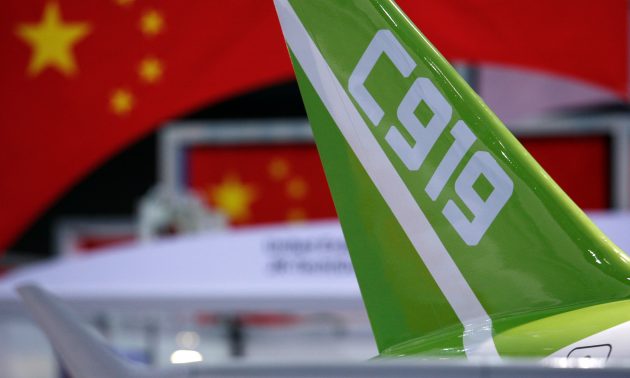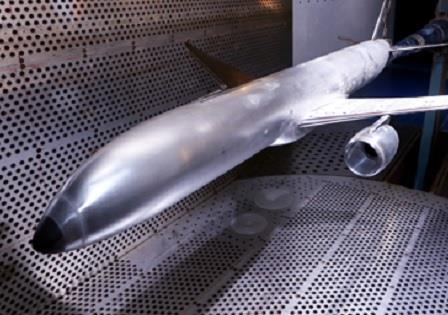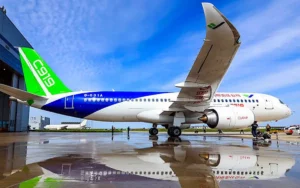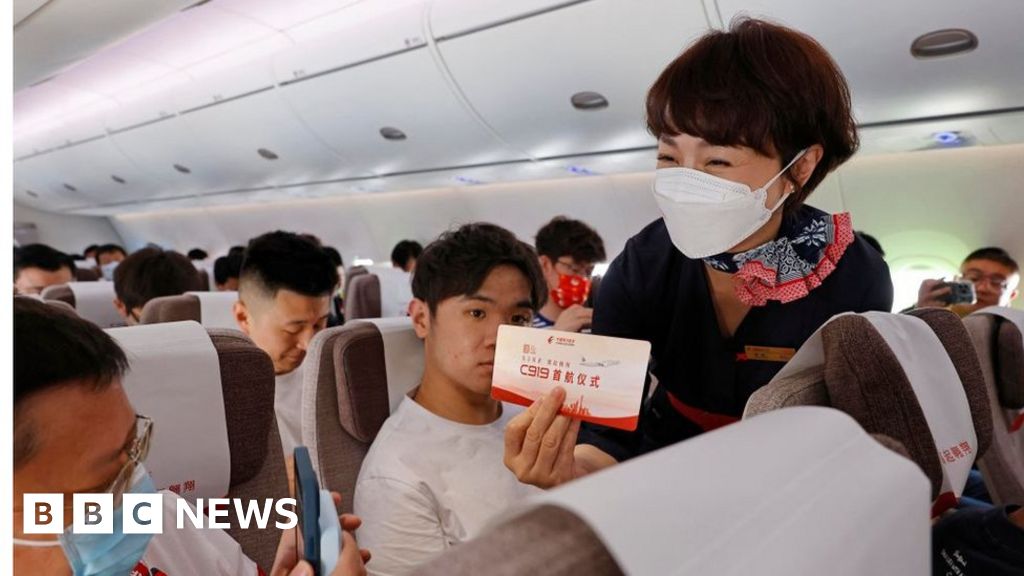ov-101
ACCESS: Confidential
- Joined
- 17 February 2013
- Messages
- 96
- Reaction score
- 57
Deino said:Congrats to a successful maiden flight today !
Will you write new reports about C919 ?
Deino said:Congrats to a successful maiden flight today !
ov-101 said:Deino said:Congrats to a successful maiden flight today !
Will you write new reports about C919 ?
ov-101 said:I had read many of you reports about Chinese aviation from Key Publishing’s magazines …And I think you will not miss maiden flight of C919
Article author: Sergey Morozov (Ukraine), winner of the Friendship Prize of the Chinese government, visiting specialist of the Shanghai Aviation Design and Research Institute (SADRI)
On May 5, 2017, a large Chinese-made C919 aircraft successfully completed its first test flight at Shanghai Pudong International Airport. I was honored to witness this great and inspiring moment in the history of aviation. Although I myself am from Ukraine, but when I saw the C919 soaring into the blue sky, I experienced incomparable pride.
I worked for 28 years in the Ukrainian Antonov aircraft concern, and then I was invited to work by the Chinese Avicorporation Avic as an expert in testing automatic control systems for transport aircraft. In 2012, I joined the Shanghai Aviation Design and Research Institute (SADRI) at COMAC. My institute takes on the important task of designing and developing large aircraft; I am mainly responsible for the study of the C919 aircraft control system. My colleagues are mainly young people who graduated from Chinese aviation institutes, I am enthusiastic to cooperate with them. In China, a large population, the development of civil aviation can not only meet the demand of people in transport, but also creates many jobs.
The first flight of the C919 is just the beginning. We must continue to make efforts, we cannot relax for a minute. After the first flight, customers often visit our company, they have very high hopes for us. I am sure that if we step by step will persistently move forward, we will certainly achieve success.
Before arriving in China, I knew practically nothing about this country. My native language is Russian and I usually communicate with my colleagues in English. When they misunderstand me, I write, draw and gesticulate. I also learn simple Chinese phrases from staff. After a few years, I can say a lot in Chinese. Today, I feel that I have truly integrated into this beautiful country. In 2018, I received a certificate of permanent residence permit for foreigners. I carry this document in my outerwear pocket and occasionally show it to others.
For 70 years, China has achieved development successes that have attracted worldwide attention. China's significant progress in various industries has laid a solid foundation for research. As for the aviation industry, in recent years, the ARJ21 short-range aircraft has already been put into commercial operation, the C919 made its first test flight. China's civil aviation is entering a new period of dynamic development. I express confidence that in the future more passenger aircraft developed by China on its own will soar in the sky.
Design challenge:But Zhao Keliang, a deputy chief designer of the C919 project, said in recent local press interviews that many foreign companies continue to support the airliner project and that GE and its partners would still ship engines to Comac to fulfill their contractual obligations, as the related deals were signed before Trump’s imposed sanctions.
-------
Wu Guanghui, the program’s lead designer, was recently quoted by a WeChat news account maintained by Shanghai government’s Media Office as saying that the C919 was on track to secure European Union Aviation Safety Agency’s (EASA) market entry approval by the end of the year.
He said the C919 has recently wrapped up its EASA extreme low-temperature tests over 23 days in January at -35 degrees Celcius, according to the report.
Wu also said testing conducted in the airspace above China’s alpine Qinghai-Tibet plateau had progressed at “warp speed,” cramming the usual half-year of testing into about three weeks with data fed live to EASA technicians.
“We found in test flights after the C919’s maiden flight back in May 2017, already three years later than originally planned, that the initial fuselage was too heavy and bulky and to get it airborne GE’s engine consumed more fuel than designed,” said the designer, who spoke on condition of anonymity.
“There are two ways to solve this: to fly the same fuselage but we need bigger wing tanks for additional fuel – that means less fuel efficiency and likely a shorter range. Or we can trim the size and weight of the fuselage, but then we have to sacrifice payloads like the plane’s passenger and cargo load,” the Comac technician said.
“Either way we take, the C919 will be far less competitive compared with [Boeing] 737s and [Airbus] 320s. Then we decided to make use of cutting-edge composite material like special aluminum to make lighter airframes.”

 asiatimes.com
asiatimes.com
China Eastern Airlines, which is the launch customer, signed a firm order on Monday to buy 5 C919 jets.



I think that ever since the events of 2018/2019 the political barriers were a given. So there wouldn't be a serious export sale of the plane outside China anyway, no matter the performance.
As for sales within China, I guess it's possible that a certain number HAVE to be purchased by state owned airlines.
But also, the way I am looking at gas prices and fuel burn data - I don't see it impossible if C919 could actually compete even if being somewhat overweight and with high fuel consumption. If the data below, that I've found, is correct:
1. A320 burns $2030 worth of fuel per hour. A320 Neo burns $190 worth of fuel per hour less.
2. A320 has a list price of $101 million. A320 Neo has a list price of $110 million.
3. If you're a huge customer, ordering dozens of planes at once and don't mind waiting a few years - Airbus will give you a huge discount. Allegedly, discounts of up to 50% off the list price were not unheard of.
4. A320 airframe life is some 60 000 flight hours. Which is usually spent within 25 years, and then the plane is retired.
So... IF C919 can manage A320 fuel burn figures, and if the plane flies 2400 hours per year, it will use $456 000 worth of fuel more than A320 neo within one year. Within 25 years that will rise to $11.4 million more. So, as long as C919 real pricetag can be kept, say, 12 million less than A320 neo with a 50% discount - meaning under $43 million - the C919 might be competitive enough for the domestic Chinese airlines. If Airbus manages to make A320 neo profitable even if it's sold at just $55 million - then I'd say it's plausible COMAC can also eventually sell C919 for 40-ish million and still be profitable.
Probably not in the first several years, until production ramps up and matures, but in the medium term - it's a possibility.
Also, how can this program be only 15% through certification test flying when the first flight was back in 2017 ?
Western manufacturers typically built three or more pre-production airframes to speed up testing. The first prototype typically does the glamorous first flight and is devoted to testing stability, control and performance. The second prototype is typically ground-tested to destruction. The third and later prototypes are used to flight test various systems: engines, hydraulics, pneumatics, cabin pressurization, electrical, fuel, flight controls, navigation, cabin entertainment, etc. By simultaneously flight-testing two or three systems - in two or three airframes - they can knock many months from flight test programs.View: https://mobile.twitter.com/ChinaAvReview/status/1551076118836326400
I had no idea they used so many prototypes during the certification program. Rumors are that the official handover to China Eastern may come as soon as next month.

Not the first per se, but the largest and the first competitive Chinese passenger aircraft.The fact that it relies on western components must not distract that this is the first Chinese built passenger plane and that they will quickly learn to manufacture their own components in the future if they are to build more civil aircraft like this.
Tbh I don't like the windshields but the wing profile is visually pleasing.
We should pressure Aviation Bloggers/Youtubers to fly on this thing

Paywalled.
Boeing blowout offers China chance to paint the skies red
Beijing’s airliner has been ridiculed by the West – but it may have the last laughwww.telegraph.co.uk

Despite keeping a low profile at the annual Farnborough International Airshow last week, the Chinese planemaker Comac still managed to dominate conversation among the 30,000 daily attendees.
At one of the biggest networking events in the aerospace calendar, manufacturing giants including Boeing and Airbus occupied bespoke hubs fitted out with luxurious facilities for entertaining airlines, wooing the press and announcing their next big orders.
Comac (Commercial Aircraft Corporation of China) could easily have funded a multi-floor complex to match its rivals, but made do with a utilitarian, modestly sized structure on the periphery of the show.
A team of about 20 people instead held catch-up meetings with suppliers to the C919, the 180-seat narrow-body plane with which it is seeking to take on the Boeing 737 Max and Airbus A320neo. Whether the company also met with potential buyers, it refused to say.
Airbus praised China’s efforts in bringing the C919 to market, but was also blunt in listing its shortcomings.
Christian Scherer, who heads its jetliner arm, said in a briefing that Comac was already a “serious competitor”, but not one that was capable of taking on Airbus in the technology stakes.
He said: “The C919 is effectively an A320neo, with the same features and the same equipment. There is no differentiation, no new value.
“When Airbus started trying to develop a technological sovereignty in commercial aviation here in Europe 50 years ago, we did not imitate another product. We brought something new that helped us accelerate our market penetration.”
[snip]
An industry source said Boeing views the C919 as most likely to garner export orders in regions where some airlines would struggle to finance Western jets, such as Africa, parts of Asia and possibly South America.
It goes some way to explaining Comac’s softly-softly approach during the Farnborough International Airshow in what was only its second ever appearance at the event.
However, in one of the cavernous exhibition halls, where companies display everything from the latest widgets to full-sized jet engines, a more overtly ambitious face of the company was evident.
On a brightly lit podium for all to see was a 6ft-long model of a wide-body jet that acted as a magnet for curious onlookers. Dubbed the C929, the proposed plane began life as a joint venture programme before a Russian partner dropped out.
Comac confirmed last year that it would move ahead on its own with plans for three variants with between 250 and 500 seats. Putting the future aircraft front and centre on the display stand seemed to convey a simple message: “We’re here and we’re not going away.”
Seriously, the Telegraph?! You don't get any useful info from the article...
China’s plot to seize control of the global jet market
After years of market dominance, the Boeing-Airbus duopoly is facing its biggest threat yetwww.telegraph.co.uk
